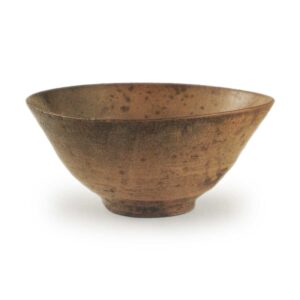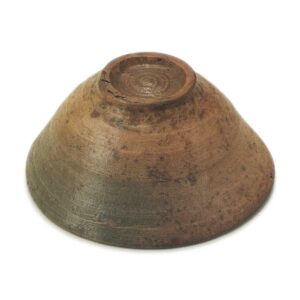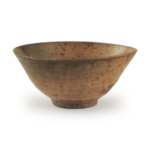

Height: 6.5cm
Diameter: 14.3-14.7cm
Outer diameter of foot: 5.4cm
Height of foot: 0.4cm
According to the book “Megurikusa”, the name is said to come from the purple glaze that appears on the inside of the bowl, and is said to be named after Edo purple.
This is a so-called “honte” tea bowl, and the shape and glaze are both extremely elegant. The foot ring is slightly lower than the overall size, and the scrape at the edge of the foot ring is also shallow. From the waist to the rim of the mouth, it is almost straight and gently widens, with fine, thread-like eyes running around it, and it is generally thinly made. There are three or four loose threads on the upper rim of the foot ring, and the inside of the foot ring is tightly carved in a fan shape, with the helmet cloth at the center, and the ground surface has a fine crease. The light brown clay is extremely fine, and the glaze is also generally thin. As usual, one side is tinged blue and the other side is tinged yellow, but the area from the foot ring to the waist is mostly yellow, and the area where the foot ring was scraped off has purple and brown spots of various sizes. The upper part of the exterior is striking in that it is a mixture of blue and yellow, and the fact that it is not perfectly distinct enhances its elegant appearance.
The rim is slightly flared, and a roundel appears in the center of the interior. There are pools of yellow glaze in the interior, and the purple glaze, which is said to be reminiscent of Edo purple, is clearly visible, adding to the quiet beauty of the interior.
There are no overall flaws, but the foot ring may have been polished slightly. This is not a showy tea bowl, but rather a simple and subdued work, with a calm and dignified appearance. According to the “Dai-en-an Tea Gathering Records”, Matsudaira Fumai used this tea bowl at a tea gathering on April 18th, 1813, and it is likely that the glaze on the surface of the bowl gave it the appearance of a spring haze. The accompanying items at the time were as follows
Hanging scroll: “Mon-nashi-kan”
Vase: “Seiji-koto”
Tea caddy: “Yama-no-i-katatsuki”
Tea bowl: “Toto-ya” “Kae-aoi-do-bera”
Inner box lid: “Edo-totoya” The inscription on the outer box lid is by Matsudaira Fumai. The “Tea Vessel Appraiser” states that “Edo’s Uo-Uoya and Sakai’s Uo-Uoya, both owned by townspeople, were the first to be requested by Ko-Enshu”, and it is said that Enshu requested them from Uo-Uoya. It was passed down in the Kobori family until 1704, when it was sold by the Kobori family along with the Hashihime tea caddy for 200 ryou on September 5th of the same year, and later passed down to the Tanuma family, as can be seen in the Kobori Family Tool Loan Ledger and the Enshu Meibutsu Ki. Furthermore, in the Kansei era, it was acquired by the tea master Matsudaira Fumai for 500 pieces of silver, and is recorded in the section on famous tea bowls in the Unshu Meibutsu Ki.








